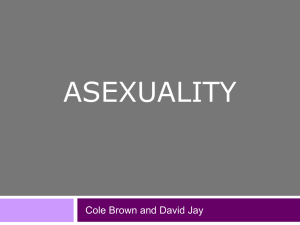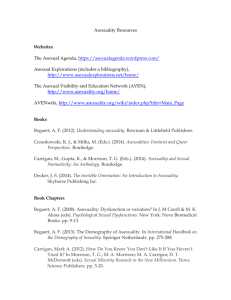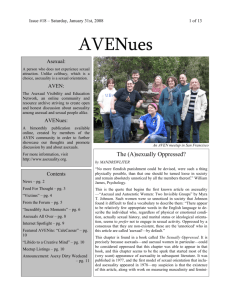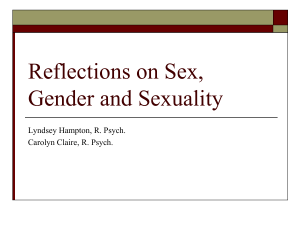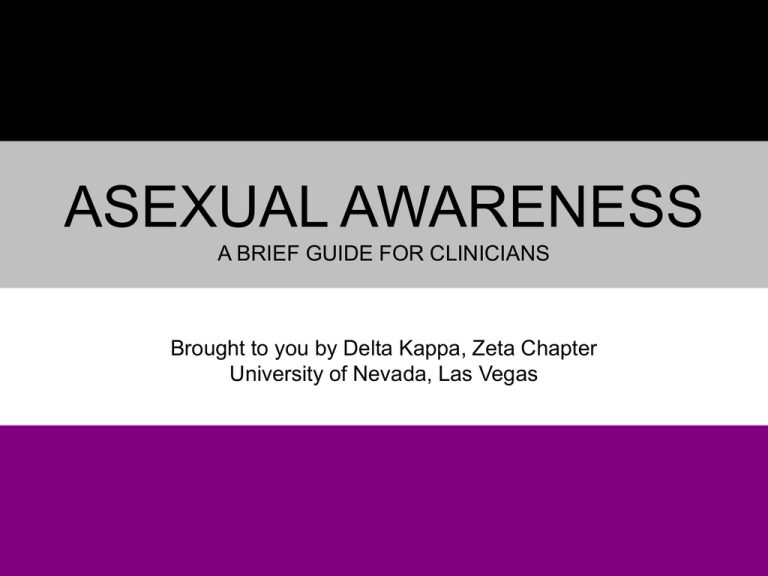
ASEXUAL AWARENESS
A BRIEF GUIDE FOR CLINICIANS
Brought to you by Delta Kappa, Zeta Chapter
University of Nevada, Las Vegas
Asexuality Defined
•
Asexual: A person who does not experience sexual attraction to people of either sex
(Bogaert, 2004; 2006). There is considerable diversity among the asexual community; each
asexual person experiences things like relationships, attraction, and arousal somewhat
differently (www.asexuality.org).
•
Prevalence: The asexual community is estimated at 1% of the US population (Bogaert,
2004).
•
Asexuality is NOT:
– …the same as sexual dysfunction
– …the same as celibacy
– …an expression of disinterest in romance
– …an expression of disinterest in physical affection (cuddling, etc)
– …an inability to achieve sexual pleasure from one’s own body (masturbation)
Asexuality in Context
•
Relationships: Asexual people have the same emotional needs as anyone else, and like in
the sexual community, they vary widely in how they fulfill those needs. Some asexual
people are happier on their own, others are happiest with a group of close friends. Other
asexual people have a desire to form more intimate romantic relationships, and will date
and seek long-term partnerships. Asexual people are just as likely to date sexual people as
they are to date each other (www.asexuality.org). There is also a difference between
romantic and sexual orientations - see the AVEN forum for detailed descriptions of these
categories.
•
Attraction: Many asexual people experience attraction, but they feel no need to act out that
attraction sexually. Instead they feel a desire to get to know someone, to get close to them
in whatever way works best for the individual. Asexual people who experience attraction
will often be attracted to a particular gender, and will identify as lesbian, gay, bisexual, or
straight (www.asexuality.org).
•
Arousal: For some sexual arousal is a fairly regular occurrence, though it is not associated
with a desire to find a sexual partner or partners. Some will occasionally masturbate, but
feel no desire for partnered sexuality. Other asexual people experience little or no arousal.
Because they don’t care about sex, asexual people generally do not see a lack of sexual
arousal as a problem to be corrected, and focus their energy on enjoying other types of
arousal and pleasure (www.asexuality.org).
History of Asexuality in Literature
•
Alfred Kinsey, the well-known developer of the “Kinsey Scale” or “HeterosexualHomosexual Rating Scale”, acknowledged the existence of individuals who “‘[did] not
respond erotically to either heterosexual or homosexual stimuli, and [did] not have overt
physical contacts with individuals of either sex in which there is evidence of any response”
(Kinsey, 1953, p. 472). In Kinsey’s work, these individuals were identified by an “X” and
were not included in his erotic spectrum (as cited in Przybylo, 2013).
•
The first mention of asexuality in professional literature was in 1977. Harvey and Jean
Gochros were the first to mention asexuality as a sexual orientation in their work “The
Sexually Oppressed”. Michael Storms followed their lead, documenting the asexual
phenomenon in his works “Sexual Orientation and Self-Perception” (1979) and “Theories of
Sexual Orientation” (1980) (as cited in Przybylo, 2013).
•
Very few sex researchers, including Paula Nurius (1983), William Masters et al (1986), and
Braden Berkey (1990) wrote about asexuality until the last decade. Anthony Bogaert (2004;
2006; 2008) is responsible for contributing the most contemporary literature on asexuality
(www.asexuality.org).
Clinical Considerations
•
From a clinical standpoint, asexuality challenges the psychopathology of “personal
distress” experienced by individuals reporting lack of sexual desire. Prause and Graham
(2007) concluded, “if personal distress is primarily due to conflicts with social expectations
or worry that a physical problem exists, then a psychiatric diagnosis implying abnormality
may exacerbate concerns in an asexual individual. While behavior that is statistically
abnormal may be problematic without a person’s full recognition of when they are behaving
abnormally, as in schizophrenia, it remains to be determined to what extent asexuality is
problematic in the absence of individual, personal distress” (p. 353).
•
Clinicians should assess for and consider the contextual factors associated with asexuality
before assigning a diagnosis of low sexual desire or sexual aversion.
•
To date, there are no specific assessment tools for asexuality; however, several
established measure may be used to gather information about a client’s sexual
attraction/arousal history:
– Sexual Arousability Inventory (SAI): Hoon and Chamblis (1998)
– Sexual Desire Inventory (SDI): Spector, Carey, & Steinberg (1996)
– Sexual Inhibition and Sexual Excitation Scales (SIS/SES): Janssen, Vorst, Finn, &
Bancroft (2002)
Asexuality Education Resources
•
“Asexuality - An Overview” (video): http://www.youtube.com/watch?v=SEeGuCCQ_8w
•
Asexuality Visibility and Education Network (AVEN). www.asexuality.org.
•
Asexuality Archive. www.asexualarchive.com
•
“Taking the Cake: An illustrated primer on asexuality”.
http://zinelibrary.info/files/taking%20the%20cake%20-%20double%20sided%20printing.pdf
•
Asexuality Common Terminology: http://asexualawarenessweek.com/docs/AceGlossary.pdf
•
Asexuality 101 (includes recommendations for asexual affirmative language):
http://asexualawarenessweek.com/docs/AceInfo-TrevorProject.pdf
•
Asexuality Explorations: www.asexualityexplorations.net
•
“No Sex Please, We’re Asexual” (article):
http://www.nzherald.co.nz/lifestyle/news/article.cfm?c_id=6&objectid=10455823
•
(A)sexual (2011). Available on Netflix.
References
Bogaert, A. (2004). Asexuality: Prevalence and associated factors in a national probability sample. The Journal of Sex
Research 41(3), 279–287.
Bogaert, A. (2006). Toward a conceptual understanding of asexuality. Review of General Psychology 10(3), 241–250.
Bogaert, A. (2008). Asexuality: Dysfunction or variation? In: Caroll, J. M. and Alena, M. K. (eds) Psychological Sexual
Dysfunctions. New York: Nova Science Publishers, pp.9–13.
Hoon, E. F., & Chambless, D. (1998). Sexual Arousability Inventory (SAI) and Sexual Arousability Inventory-Expanded
(SAI-E). In C. M. Davis, W. L. Yarber, R. Bauserman, G. Schreer & S. L. Davis (Eds.), Handbook of sexualityrelated measures (pp. 71–74). Thousand Oaks, CA: Sage Publications.
Janssen, E., Vorst, H., Finn, P., & Bancroft, J. (2002). The Sexual Inhibition (SIS) and Sexual Excitation (SES) Scales I:
Measuring sexual inhibition and excitation proneness in men. Journal of Sex Research, 39, 114–126.
Jay, D. (2006). Asexuality Visibility and Education Network. www. asexuality.org
Kinsey, A. C., Pomeroy, W. B., Martin, C. E., & Gebhard, P. H. (1953). Sexual Behavior in the Human Female.
Philadelphia and London: W.B. Saunders Company.
Masters, W. H., Johnson, V. E., & Kolodny, R. C. (1986). Masters and Johnson on Sex and Human Loving. Boston:
Little, Brown and Company.
Nurius, P. S. (1983). Mental health implications of sexual orientation. The Journal of Sex Research 19(2): 119–136.
Przybylo, E. (2013). Producing facts: Empirical asexuality and the scientific study of sex. Feminism & Psychology,
23(2). 224-242. doi: 10.1177/0959353512443668
Spector, I., Carey, M., & Steinberg, L. (1996). The Sexual Desire Inventory:
Development, factor structure, and
evidence of reliability. Journal of Sex & Marital Therapy, 22, 175–190.


